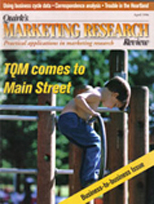Editor’s note: Leslie M. Harris is chairman emeritus of Focus on Boston and founder of the International Network of Focus Group Research Centers. This article is based on conversations with a number of researchers who frequently conduct business-to-business projects.
In business-to-business research, often the learning from focus groups generates an interest in further learning - both for strategic/planning purposes and to illustrate findings for sales force members and other channel representatives. Terry Pranses, president of T. Pranses Consulting Services in Hoboken, N.J., uses Up-Close ethnographies to help achieve this result. These are in-depth interviews conducted at the respondent’s workplace which illuminate not only his/her relationship to the product category, but also their entire work environment, the roles of other decision influences and their personal side. Pranses brings these findings to life with a video distillation of the interviews or a slide-and-script presentation.
Judy Hoffman, president of Profile Marketing Research in Lake Worth, Fla., reports that her company is conducting more and more business focus groups via teleconferencing. Her clients see the value of being able to have national or international participation within a given session. Often, materials are faxed to the participant just prior to or even during the session, thus minimizing any hesitancy that might exist with regard to competitive issues.
Within the context of the teleconferenced focus group, Profile Marketing has successfully used an on-line connection with client observers/listeners, who link up via their client’s E-mail system with an access point for their use or via a third party provider.
Vicki Savala, president of ACG Research Solutions, St. Louis, says that her business-to-business clients are increasingly interested in incorporating interactive hand-held dialer technology into their focus groups. This technology, which ACG calls RAMS (Rapid Analysis Measurement System) Interactive, offers the clients the opportunity to receive second-by-second analysis of audience reaction to visual test material.
Be eclectic
With executives, it is frequently necessary to be eclectic, says Alan Bell, president of Bell Associates in Cambridge, Mass. One project may require many different information gathering techniques. One such project undertaken by Bell Associates involved evaluating the opinions of executives on moving their businesses into or out of the downtown Boston area during the replacement of the Central Artery, an interstate highway that crosses central Boston.
Bell found that a singular approach was not expedient. For some respondents, a conference call was more convenient; for others, an electronic forum or "side conference" room on the Internet or a specialized electronic bulletin board service was an attractive medium. Some wanted to respond via their company’s new "video link;" others preferred to communicate by fax. Still others opted for the in-person communication.
According to Siri Lynn, president of The Idea Exchange in Fairfield, Conn., clients seem to want to explore new avenues for gaining information about their business-to-business products and services. They are interested in end users’ perceptions. They are identifying new contacts/sales targets outside the normal channels (i.e., offering telecommunications products to sales managers so the sales become internally driven rather than relying strictly on telecom decision makers).
Many are also taking into account their own reps’ views of the market, comparing reps’ expectations and reactions to what customers themselves are saying.
One trend noted by Tom Greenbaum, president of Groups Plus in Wilton, Conn., is the growing sophistication in utilizing research techniques by business-to-business companies. In the past, consumer companies were more sophisticated in their use of research because their people had been trained in the use of research technologies. In the business-to-business environment most marketing people were sales people who had been given the added responsibility of using research without knowing how to use it. Today more business-to-business companies are staffed by consumer goods-trained marketing people who understand the research function and what is needed to carry out good research.
Some other thoughts:
- Business-to-business clients want to return home with tangibles. Often that means that rating and sorting exercises are important. These often require handouts or props. (T. Pranses)
- Clients increasingly are interested in how fast research firms deliver data once they have given the green light on a project. Recruiting, questionnaire development, conducting the group and report are generally expected within three or four weeks unless a large number of groups are needed. (T. Pranses)
- The cost/benefit ratio has reduced the size of focus groups to seven to eight participants. (J. Hoffman)
- Focus groups are often scheduled to last two-and-a-half to three hours, assuming there is sufficient interest in the subject matter on the part of participants and assuming decent incentives. (J. Hoffman)
- Clients are more frequently seeking quasi-quantitative data that can be collected through focus groups, during which respondents are asked to complete a written quantitative questionnaire or to complete a card-sort exercise. (V. Savala)
- Breaking the target sample of respondents into smaller groups is often the only way to obtain the data you need. (A. Bell)
- Respondent specifications are changing, thereby offering new dimensions to business-to-business research and findings. (S. Lynn)
- Although the number of on-line focus groups and surveys will increase, there is still a great amount of benefit in communicating directly either in person or over the telephone. However, as people become more familiar with communicating on line, opportunities for targeting business and professionals will grow dramatically. (J. Hoffman)
